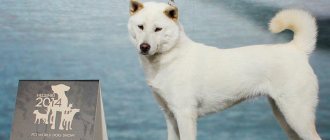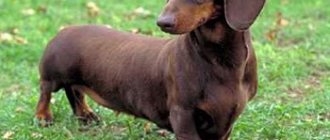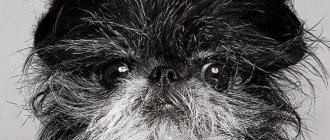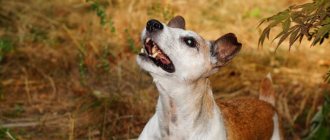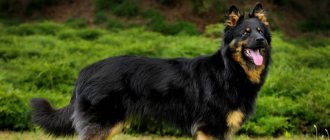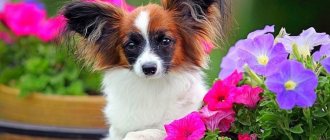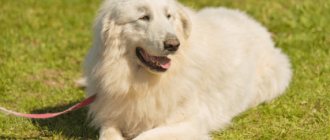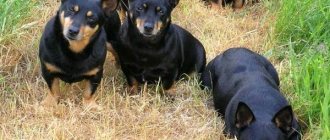Care and maintenance of the Otterhound
With good care and careful attention to the health of pets, Otterhounds can live up to 15-16 years, although their average life expectancy is from 10 to 13 years.
Physical activity and training are urgently needed for dogs of this breed. Dog competitions for hunting breeds, accompanying the owner on jogging or cycling walks, agility, swimming in various bodies of water - all this will help the dog be in good shape and mood. In addition, regular sports activities help control weight in dogs prone to obesity (especially neutered males).
The coat needs to be brushed weekly with a stiff brush, otherwise tangles will form. While in pet dogs these lumps can be cut off, in show dogs this is unacceptable; the hair in the area where it is cut takes quite a long time to grow back. The beard on the Otterhound's face requires special attention. While eating, pieces of food and water get stuck in the long hairs and if they are not removed immediately after eating, they begin to smell.
The Otterhound feels perhaps even better in water than on land. Photo by: Linda.
Droopy ears should be periodically examined by a veterinarian for the appearance of plugs, which can lead to inflammation - otitis media.
As a large and restless dog, it is better to keep the Otterhound in a private home rather than in an apartment. They should have a fenced-in area for walks in which they can splash out their energy. Hounds can live in the yard, but only if they have good shelter, a booth or an enclosure. Due to their thick coat and undercoat, they tolerate cold more easily than heat.
Care
Seeing the thick coat of Otterhounds, you might think that such coat requires a lot of care, but this opinion is wrong. Maintenance is not a hassle. But still:
- Long and thick coat requires proper attention. It is enough to brush your dog once a week. The wool does not get tangled with each other. They don't shed much.
- You must remember to regularly wash your beard with it, otherwise it may give off a bad smell.
- Ears require care and attention. Ear plugs may form in them, and if I do not remove them, this will lead to inflammation of the ears (check daily). Wiping and cleaning your ears is a must.
- They love to swim. Washing them with shampoo is often not recommended (it dries out the skin). However, shaggy hunters will happily take a cool shower every day.
- Check your teeth. Plaque can be removed using special hygiene products.
- Otterhounds must be vaccinated or else they can become infected with various diseases that can even lead to their death.
Price
It is difficult to buy an Otterhound puppy in Russia due to the current unpopularity of the breed. In Western nurseries, in the dog’s homeland in Great Britain, the price of an Otterhound is no less than $300. The cost of a puppy is influenced by factors of good pedigree, prestige of the breeders, age, health of the animal, color.
Before purchasing, you need to talk to your future pet; the dog must be active and friendly. Signs of aggression and increased anxiety reflect problems with the puppy’s psyche. An expensive purchase should not be a mere whim of the owner. The small life of a purebred pet requires responsibility, care, and human love.
Where to buy and price
The Otterhound is a rare and uncommon breed in Russia. Most of its population is found in England, Germany and several other European countries. Not a single official nursery is registered in Russia. To get such a breed, you will have to travel abroad. Otterhound puppies will cost from 48,000 rubles. (from $800).
Pros and cons of the breed
| + | — |
| Good hunting dog | A very rare breed of dog |
| Has an amazing sense of smell | Not suitable for apartment living |
| Loves children | Difficult to train |
| With proper upbringing, he can get along with cats and dogs. | It is almost impossible to buy a puppy in Russia |
| Has good health | Not suitable for the role of a guard dog |
| Sheds rarely and little | |
| Good companion | |
| Successful in agility |
The Otterhound is an extremely rare breed of dog. They make good companions and companions for children. Otters are not suitable for apartment living and require constant movement. They love hunting and will not be able to live in cramped conditions.
Description and features
The breed's specialization is otter hunting in marshy areas. Hound dogs do an excellent job of finding an animal's lair under water, and they track down prey of other types on land as well. The physical form of dogs reflects their readiness for exercise. Powerful skeleton, muscular body, large head. The floppy ears are set low and pressed tightly to the sides. At the ends they are curled into a curl, which uniquely distinguishes the Otterhound breed.
The expression on the face is friendly, the look of the shaggy pet is very expressive, reflecting interest, strength, and independence. Dark eyes are covered with fur. The nose is graphite-colored or brown. The Otterhound has an excellent sense of smell and a rare bass voice.
Free movements of the hound, a wide step in gait resembles an active trot. The dog has a huge pushing force to accelerate the sweeping run. The dog quickly catches up with its prey. Surprisingly, when walking, the dog seems to drag his feet, barely lifting them from the ground.
The peculiarity of movement is deceptive - thanks to their strong limbs, dogs are able to tirelessly cover tens of kilometers. The height of the dog at the withers is approximately 65 cm, weight is 35-50 kg. Males are large in size and weight. A straight, saber-shaped tail, wide at the base and narrow at the tip.
The Otterhound has a peaceful, active character.
Dogs became excellent swimmers thanks to their long limbs with membranes between their toes. The widening of the feet in the water helps the animal to successfully row at a decent speed. Webbed feet with large black pads.
For water hunting, nature has endowed dogs with special hair. Double waterproof cover, slightly oily to the touch. The guard hair is like a wire, hard, rough, and has the property of curling. The length of the fur on the body is up to 8 cm, on the limbs it is half as long. Dense fur allows the dog to work even in icy water.
The Otterhound in the photo captivates with its spontaneity, playfulness, and shaggy appearance. Deviation from the standard in the presence of very long hair leads to disqualification, as it interferes with the working qualities of the dog. When wet, the severity of the coat reduces the physical resource of the animal.
The curly coat was admired in the past by the royals of the English court. Modern dogs are allowed to be exhibited in their natural form - with unkempt fur without tangles, feathering or dewlap. When preparing a dog for showing, you can comb the dog's coat, but do not cut it. The color is allowed in one color or in combinations of several colors. The pigment of the coat should match the shade of the nose and eyes.
History of the breed
People have been hunting otters since ancient times, since they, in turn, feeding on fish, significantly reduced the catch of fishermen. Over time, people realized that specialized dogs were simply necessary to hunt otters, which could provide decent resistance and weigh about 10 kilograms. Its appearance raises many doubts and disputes.
The bewilderment is, of course, understandable, because it was originally bred as a terrier (burrow breed), rather than a hound (hound), which would not hesitate to rush into cold water to chase otters. Some authors believed that the "Southern Hound" and the "Welsh Harrier" were its ancestors.
This theory is understandable, since many of the dogs this article is about lived in Wales and Devonshire, which at one time were the habitat of the “southern hound”. Others wrote that as a result of selection, she received wool from the “Water Spaniel”, and endurance from the “English Bulldog”. The French Griffon Niverier and the English Foxhound have been suggested as complements.
The history of the Otterhound dates back to the 13th century, when King John hunted with a group of these dogs.
In the 14th century, Edward II received the first title of Master of the Breed in England, along with Elizabeth I. Henry VI, Edward IV, Richard II and III, Henry II, VI, VII and VIII and Charles II each held the title at various points in history.
The peak of its popularity in England fell in the middle of the 19th century. In the second half of the same century, this dog became almost identical to the one we know today. According to available data, as many as twenty to thirty dogs of this breed were hunted regularly throughout the hunting season in order to reduce the number of river otters, thereby preserving fish as a human food source.
They were very skilled in their work and soon the otters began to disappear. In 1978, Great Britain passed a law banning the hunting of beavers and otters to preserve their populations. Two years later, Scotland adopted this law, which led to a sharp reduction in the number of dogs of this breed. After which a club for lovers of these dogs was formed in the UK to prevent its extinction.
Unfortunately, many kennels were destroyed by their owners and eventually only two kennels with a total of 100 dogs remained in all of England - one in Kendal and the other in Dumfries. Thanks to Otterhound enthusiasts, these large, shaggy dogs have found a home in the show circuit, where their interesting appearance and adorable personality have elevated them to favorite status.
The Otterhound has never been wildly popular compared to other terriers. However, their wisdom and disheveled appearance have allowed them to be heard by almost the entire world, but today they are rarely used for hunting. However, their keen sense of smell, cheerful nature and athleticism help them win advanced titles in agility, obedience, utility and other disciplines.
general characteristics
Otterhound, a dog belonging to the hound class. Its main characteristics:
- Large head.
- Powerful skull.
- Scissor bite.
- The muzzle is slightly elongated.
- Hanging ears.
- The body is slender with pronounced muscles.
- Strong paws. There are webs on the paw pads. They help the dog stay in the water for a long time.
- Long, thick coat with very good undercoat. Wool length 15 cm;
- The color can be with shades of blue or white (may have shades of black).
- At the withers, adult dogs can reach 68 cm.
- They weigh from 45 to 52 kg.
- Life expectancy is up to 13 years. There have been some cases where the dog lived to be 16 years old.
Tornjak: a brief historical background
Tornjak (or Tornjak) belongs to the group of mountain herding dogs. The appearance and skeletal structure of the breed suggest that its roots come from Tibetan mastiffs. The first descriptions of this dog date back to the 9th century. It originated in the Balkans, or more precisely, in the region now part of Bosnia and Herzegovina. Most of the population here was engaged in sheep farming, since the mountainous terrain is not particularly suitable for growing crops. Tornjaks performed and still perform the role of guards and protectors of sheep from attacks by predators. Any farm keeps several of these dogs to ensure the safety of the herd at night and during the period of free grazing.
The function of the tarnjak is protection from predators during the day and at night; it does not control the behavior of sheep
Previously, this breed was called differently:
- in Bosnia - Bosnian Shepherd dogs;
- in Croatia - Croatian mountain dogs.
The name Tornjak comes from the word “thorn” - a pen for livestock, and is associated with the main focus of the use of these domestic animals.
Despite the popularity of Tornjaks in this region, the breed could have disappeared if not for the enthusiasm of local dog handlers. In the small town of Travnik, located between Sarajevo and Banja Luka, a dog breeders club was created to revive the breed and its official recognition. At the request of the club, a monument to Tornjak was erected in Travnik.
A monument to the dog was erected near the playground, which once again emphasizes the good-natured attitude of this big dog towards children.
At the same time, work was carried out in Croatia. The work of dog handlers to restore the breed has yielded the following results:
- purebred breeding began in 1978;
- in 1981, the breed was registered in Yugoslavia itself under the name Bosnian-Herzegovina-Croatian Shepherd Dog (Tornjak or Tornjak);
- in 1990, a breed standard was adopted;
- in 2007 - official recognition by the Federation Cynologique Internationale (FCI); Its registration record is numbered 355.
After receiving official status, dogs of this breed can often be seen at international exhibitions.
Now in the territory of the former Yugoslavia there are a large number of purebred representatives of this breed.
Photo and brief description
The Otterhound is an old British breed, the dog’s appearance is noble and sweet, you can see this for yourself by looking at the photos that we have selected for you.
The curly fur of this dog evokes special affection in many people. Because of its unusual appearance, it is very easy to remember. The Otterhound gets along well with children. He will never bark without the necessary reasons, because he has great intelligence. He respects his owner very much, but also expects the same attitude towards himself.
general characteristics
Otterhound, a dog belonging to the hound class. Its main characteristics:
- Large head.
- Powerful skull.
- Scissor bite.
- The muzzle is slightly elongated.
- Hanging ears.
- The body is slender with pronounced muscles.
- Strong paws. There are webs on the paw pads. They help the dog stay in the water for a long time.
- Long, thick coat with very good undercoat. Wool length 15 cm;
- The color can be with shades of blue or white (may have shades of black).
- At the withers, adult dogs can reach 68 cm.
- They weigh from 45 to 52 kg.
- Life expectancy is up to 13 years. There have been some cases where the dog lived to be 16 years old.
Breed dossier
- Country of Origin:
USA - Classification:
Group 6: Hounds and related breedsSection 1: Hounds
- Training:
The Foxhound needs consistent and careful education, early socialization and training to unquestioningly obey the owner. It is not easy to achieve understanding and obedience to the master’s commands from a foxhound, but when all pedagogical obstacles are overcome, there is no doubt: the dog’s natural endurance will allow the dog to hunt in any weather conditions. - Color:
Brown and white, black and brown or black-white-brown tricolor, although different color variations are allowed. - Dimensions.
The height of a male is no less than 56 cm and no higher than 63.5 cm, that of a female is no less than 53 cm and no more than 61 cm. Weight is 30-34 kg. - General impression:
Characteristic detail: jowls (lips) hanging below the jaw. - Usage.
A great hunter and a wonderful companion. This is a first-class hunting dog that is used to hunt foxes and wild boar. In addition to fox hunting, this dog “specializes” in raccoons, opossums, as well as “more serious” game, such as bear or cougar.He works both in a pack and in splendid isolation, although many representatives of this breed prefer to hunt in the company of their “colleagues”.
- Physical activity:
Space, regular active physical activity, regular exercise in what they love – hunting – are the basis of a full-fledged lifestyle for these dogs. They are amazing runners: if you leave a Foxhound in an area of 200 m2, after covering it in a day, he will come back happy and ready to run the same distance again! - Personality:
Foxhounds are distinguished by their independent disposition and considerable stubbornness, which creates certain difficulties in the training process. The American Foxhound has enormous endurance, patience and the ability to adapt to weather and hiking conditions. The Foxhound is balanced and obedient, but his character can become wayward and obstinate if, from childhood, you do not devote enough time and patience to his upbringing and training, but treat him like a domestic decorative dog. - :
This independent dog with an independent character is not suitable for a beginner. Not suitable for the role of a pet. - Grooming:
This dog's coat requires regular but simple grooming. - Friendly:
The American Foxhound gets along well with children. As a rule, he does not show aggression towards other pets, which cannot be said about unfamiliar dogs. Although he will not show aggression towards them, he will be wary at first. - Diseases:
Fairly healthy breed. American Foxhounds are in excellent health and free of all the genetic diseases (such as hip dysplasia) that affect large dogs of other breeds. Do not overfeed as they are prone to obesity. - Diet:
Unpretentious in food. - Life expectancy:
11-15 years.
Description of the Otterhound breed, characteristics
The peculiarity of Otterhounds is that, like Newfoundlands, they have membranes between their toes. This gives them the opportunity to swim beautifully. After all, it is known that otters, the object of their hunt, live in water. If an Otterhound sees air bubbles on the water, he will definitely jump into the water. It is the bubbles that indicate the presence of an otter underwater. But the water temperature does not matter for the Otterhound.
Even now, living in an urban environment, if you go for a walk with the owner to a lake or pond, and see bubbles on the water, he will definitely jump into the water. Even if the dog has never been hunting and has never seen an otter. This is where gene memory is triggered.
Character of Otterhounds
This is a friendly, noisy, even-tempered hunting dog with a very sensitive scent. He loves his family, but does not require their constant attention . He will be happy to see you come through the door, but afterward he will return to his corner to continue his nap.
He has an excellent sense of smell and will go far following a scent that interests him, so he must be kept on a leash or in a fenced yard at all times. This pet, of course, has its own opinion, but it is trainable. It just depends on the patience and skill of the trainer. This breed loves to have something to do and once he has something to do, he is ready to work all day.
He gets along with other dogs and animals if he grew up with them . He is also friendly with children , but is a large and clumsy dog, so he can easily accidentally knock over an unsteady toddler. He is a good guard dog and has a lovely, deep bark that will likely annoy your neighbors . This breed has a unique sense of humor and the heart of a joyful child.
Otter hound color
- Black,
- Grey,
- Wheat,
- Blue and Cream,
- Liver and brown,
- Black and brown and tan
Otterhound breed standard
- FCI Standard No. 294 / 01/27/2011
- Origin: UK.
- Date of publication of this standard: 10/13/2010
- Use: A large, strong hound, designed primarily for long, all-day work in the water, but capable of galloping on land.
- FCI classification:
- Group 6. Track hounds and related breeds.
- No operational tests.
Section 1.1 Large hounds.
- CRANIAL PART
- Skull: Beautifully domed, not coarse or overdeveloped, rising from the stop to the slight crest of the occipital protuberance. No signs of frowning or bulging forehead.
Stop: distinct, although not excessive.
- Nose: good width, with wide nostrils.
- Topline: straight.
Back: wide.
- FORE LIMBS
- Shoulders: Clean and well sloping.
Forearms: Strong boned, straight from elbows to ground.
- General appearance: very strong; well muscled when viewed from any angle, not too wide or too narrow. Moderate angles of articulation of the hind limbs. In a natural stance, the hind legs from the hock are perpendicular to the ground.
- STRUCTURE 4-8 cm long, thick, rough, hard and water-repellent, but not wiry; looks broken. Softer hair on the head and lower legs is normal. The undercoat is pronounced, and there may be a slight grease on the topcoat and undercoat. Not trimmed for display. Must be displayed in its natural form.
COLOR All recognized hound colors are allowed: solid, grizzly, sand, red, wheaten, blue; there may be slight white markings on the head, chest, paws and tip of the tail. White hounds may have small lemon, blue or badger pied markings. Black and tan, blue and tan, black and cream, there are brown, brown and tan, white and tan. Not allowed colors: brown and white, dogs with a white body and black and red-brown clearly separated spots. The pigment should be in harmony, although it does not have to match the color of the coat; for example, tan dogs may have a brown nose and eyelid rims. A slightly unpainted nose is permitted.
- Aggression or cowardice.
Any dog with physical or mental abnormalities shall be disqualified.
Abilities and training
Initially, the German Hound breed was conceived as exclusively a breed for hunting. However, the representatives’ abilities were not limited to hunting skills inherited from their ancestors. The German hound easily learns new commands, is capable of guarding the territory, and protecting the owner and his family members. The dog's intelligence is rated above average.
This is a rather passionate, hardy, courageous dog that shows good endurance and stability in difficult circumstances. It is these qualities that make the German hound one of the best in the hunting business. These are excellent companions who love and are ready to serve their master faithfully.
With adequate and competent training, they show good abilities in hunting both large and small game. Works on dry and blood trails. Fast, strong-willed and purposeful. Orients himself well in space, finds his way in unfamiliar places.
With good maintenance and appropriate care, life expectancy is ten to twelve years.
Character
The breed has been created for centuries, although it was officially recognized by dog handlers quite recently. The dog has long been loved for its playful nature, trustfulness and friendliness. Pets simply cannot imagine that someone is capable of offending them. Naivety and childlike purity distinguishes even adult dogs.
The intelligence of a pet is manifested in the ability to get along with everyone, not to bark over trifles, and respect for the owner and members of his family. He loves to play with children, but avoids becoming a toy himself, demanding respect. The character of the Otterhound is revealed in devoted, honest service, which makes the dog a member of the family. An important feature of an animal is the ability to occupy itself with some activity.
As a rule, this is playing with an object, observing something, accompanying the owner. It is better to keep your pet on a leash during walks. A keen sense of smell and hunting passion turn out to be stronger than proper upbringing. The dog can take the scent, run away in an unknown direction, and get lost.
Communication with the owner is expressed in a rich range of sounds that the pet makes in a funny way. In addition to a deep bark, which is rare and for good reasons, the Otterhound can mutter, sniffle, grumble, and sometimes even grunt.
The pet is quite peaceful with other animals, as long as good upbringing allows. But “home alone” situations can end in chasing a domestic cat. Keeping several Otterhand dogs in the house shows that they get along with each other, are very friendly, and playful.
Education and training
Greyhounds are rarely seen on training grounds, which is why they have a reputation for being difficult to train and lazy. However, in reality everything is not so clear. Like any dog originally “sharpened” for hunting, English greyhounds cannot carry out commands with the automaticity with which service breeds can do so. But the “English” love to be creative and are very artistic, which gives them advantages when performing in the ring.
Unlike the above-mentioned service breeds, it is better not to rush into training English greyhounds. Be patient and persevering, let the puppy grow up. At a young age, greyhounds are fantastically uncontrollable, so trying to curb the irrepressible energy of a three-month-old baby means ruining the mood for yourself and your pet. It’s better to practice your ability to calmly deal with dog pranks, which the puppy will generate a pack per hour.
Typically, dog handlers recommend working with a dog no earlier than it is one year old, but do not take such advice literally. By this age, Gray is obliged to do something. In particular, the greyhound must respond to its name, understand prohibitions, and also be socialized.
Greyhound training is structured with an eye to the breed’s psychotype. English greyhounds are not the kind of dogs that are eager to work for food: they will swallow the offered treat and make “adios” with their paw. So the main incentive for training remains the innate passion of the breed
Try to “grab” your pet’s attention during the first lesson and not let go during subsequent lessons. Remember, as soon as a Greyhound gets bored, he will quit studying.
It is better to choose a moderately patronizing style of communication during training: greyhounds are not dominant, and it is pointless to “press” them. It’s better to show your pet how happy you are to work together - the dog will appreciate it.
There are some difficulties in mastering the basic set of commands. For example, greyhounds have a hard time with any demands related to waiting, since due to their anatomy, it is unpleasant for them to sit for a long time, leaning on their hind legs. However, no matter how sorry you may be for your pet, you will have to start training with the commands “Wait!” and “Sit!” The only thing is to be a little lenient with the dog’s physical capabilities. The Greyhound did not take the required expectant position, but simply sat down? Already good. Give the hard worker a compliment - he deserves it.
Whatever they say about the inattention and laziness of the breed, English greyhounds are capable of such disciplines as agility, OKD and even search work. True, not all owners are ready to send their pets to some kind of course, motivating their decision by the fact that professional training will “dumb down” the working qualities of the dog. This cliché is quite common among dog lovers, but has no basis in reality. Rest assured, a greyhound who has mastered the intricacies of OCD will chase a mechanical hare with the same passion as an untrained animal.
Who is this breed suitable for?
Each breed needs an individual approach. Some people are easier to get along with, while others will take some work. The Otterhound is suitable for people with a persistent character who can force themselves to be respected and obeyed.
This breed of dog is not suitable for older people and it is also not recommended for beginners to get one, as it will be difficult for them to cope with it.
Otterhounds subtly sense the owner’s character and try to find his weakness, so it is advisable to train him with a firm hand. Otherwise, shaggy hunters may imagine themselves as masters of the house.
Caring for Drahthaars
The Drathaar is a fairly unpretentious breed. A dog can live either in a house or apartment, or in an enclosure. She is also not particularly picky about food. You can bathe your dog with shampoo 2-3 times a year, or you can not do it at all. As for the claws, most often their trimming is not required for the simple reason that they grind down on their own.
If the dog's owner is a great esthete, then caring for it can be made more civilized. For example, do regular examinations of the ears, eyes, paw pads, partitions between the toes, and strengthen antiparasitic measures to prevent infection by helminths and ticks. You can also constantly monitor the appearance of the coat. This is especially true during the molting period or if the dog regularly takes part in exhibitions.
It is important to understand that the structure and thickness of the coat varies among different representatives of the breed, which, in fact, determines the severity of shedding. Regular brushing is necessary for the animal's coarse and long fur.
If this is not done, then excess undercoat may form, and the guard hair will not fall out completely during the molting process. It is highly advisable to trim the hair on the head of puppies and juniors that is too soft before the age of one year. The same applies to too long hair, because it will greatly interfere with hunting.
Drathaars are not at all afraid of water and love to swim in bodies of water, so you should not deprive them of this opportunity, since a constant excess of energy requires an outlet. Dogs also love to engage in any sport: running, jumping, playing catch.
Choosing an Otterhound puppy
To assess the general condition of the baby, carefully carry out a few simple manipulations:
- examine the dog's eyes. There should be no defects or clouding. The presence of a red swelling at the outer corner of the eye will require surgical treatment, and an inflamed third eyelid indicates an infection;
- touch your nose. In a healthy puppy it is wet and cold. Otterhounds do not make any sounds when breathing; snoring and coughing are signs of illness;
- examine the muzzle. The teeth should meet in a scissor bite when closing the mouth. Minor curvatures do not affect health, but reduce the dogs’ chances of participating in exhibitions. A pronounced defect will affect digestion in the future;
- examine the auricle. Its outer side should be evenly covered with wool. Scratching and scabs are not allowed. There may be bites on the ears from playing with his brothers, this is not scary. There should be no unpleasant odor coming from the ear canal. Any discharge is a sign of pathology. If your baby's ears itch, he will shake his head and become restless;
- Place the puppy on its back on your lap. A calm dog will become quiet after several attempts to roll over. The abdomen should be clean, soft, painless. A protruding belly button may be a sign of a hernia, but this pathology can be easily corrected in a veterinary clinic;
- examine the dog's fur. The hair should be smooth, shiny, glossy. Bald spots and excessive shedding are a deviation from the norm.
Caring for Bloodhounds
What's great about Bloodhounds is their short hair. Considering the size of the dog and the overall surface after smoothing out the folds, there will not be enough time to comb him. But all they need is treatment with a brush and a special hard mitten twice a week.
The dog can also do without special bathing. In summer he can wash himself in a pond if he wants. But the ears and folds on the face need to be cleaned. Dogs' floppy ears collect dirt, and under them, increased humidity provokes the development of infection. At least once a week they are wiped with cotton wool or a sanitary napkin from the inside.
Eyes require special attention. Sagging eyelid skin creates a gap where secretions can accumulate and dust can get in, which causes inflammation of the mucous membranes of the eye. Eyes are examined regularly and washed as needed. You can use a human remedy - tea
It is necessary to pay attention to the condition of the eyelids - dogs are prone to eversion and inversion of the eyelids
To keep a powerful dog in good physical shape, you need to drive him a lot, not letting him forget that he is not only a “sniffer”, but also a hound. An active walk for an hour and a half is what he needs. It’s good if his needs coincide with his master’s. It is useful to take a ball for a walk so that you can run less, or a bicycle.
To prevent the talents of a hereditary hunter from going to waste, it is useful to take part in field tests and competitions on the blood trail of hunting dog breeds. The dogs are tested to determine their hunting skills. At competitions, winners are determined by evaluating not only dogs, but also kennels and owners. The tests are necessary for those who desire a show career.
Origin story
The Otterhound (literally, otter hound) is a hunting dog breed developed in Great Britain. Scientists have no documented evidence of the origin of Otters, but believe that they are related to the French Griffons, Bloodhounds, Water Spaniels, Southern Hounds and Welsh Harriers.
The first mention of the breed dates back to the 13th century. Otters were kept at the royal court and used to hunt otters. Hounds gained wide popularity only in the 19th century, when this type of hunting became fashionable among the English aristocracy.
In the 20th century, otters were on the verge of extinction; the state banned their extermination. Otters lost their “jobs” and the breed began to die out. Enthusiasts began to use Otterhounds to hunt mink, raccoons and even bears. This allowed the population to be preserved and the restoration of the breed to begin. Unfortunately, otters are still endangered and their numbers are extremely low. The breed was recognized by the FCI in 1974.
Breeds from the same group
- Australian (kangaroo) greyhound
- Australian Terrier
- Austrian Shorthaired Pinscher
- Azawakh
- Ainu (Hokkaido Inu, Ainu-ken, Hokkaido dog, Hokkaido)
- Akita Inu
- Alopekis
- Alaskan Malamute
- American Blue Gascony Hound (Big and Blue)
- American Indian dog
- American Cocker Spaniel
- American Staffordshire Terrier
- American Toy Terrier (American Toy Fox Terrier)
- American Foxhound (American Foxhound)
- Amur Laika (Indana)
- Anatolian Shepherd
- English Beagle
- English cocker spaniel
- English Pointer (Pointer)
- English Setter (Laverack)
- English Foxhound (Foxhound, American Foxhound)
- Dogo Argentino (Argentine Mastiff, Dogo Argentino)
- Artois Hound (Chien d'Artois)
- Ariège marriage (Ariege pointer, artesien Norman, bracque de Toulouse)
- Afghan Aboriginal Hound (Bakhmul)
- Afghan Hound (Afghan)
- Africanis (lion dogs)
- African hairless dog
- Affen pinscher (monkey pinscher)
- Bakhmul (Afghan Aboriginal Hound)
- Banjar Greyhound
- Basenji (Nyam Nyam Terrier)
- Basset Hound
- Batak Spitz (Pomeranian dog, Batak dog of Sumatra)
- Bedlington Terrier (Rothbury Terrier)
- Beagle Harrier
- Billy (Biya)
- Dogue de Bordeaux (Dogue de Aquitaine, French Mastiff)
- Bosnian Barrack (Bosanski Gonjic, Bosnian Rough-haired Hound, Ke
- Fila Brasileiro (Fila Brasileiro, Brazilian Mastiff, Brazilian Mol
- Breton fawn basset (Breton Basset, Red Breton Basset)
- Bourbon braque
- Buryat-Mongolian wolfhound (Hottosho)
- Wachtelhund (German Spaniel, German Quail Dog)
- Welsh Springer Spaniel
- Welsh Terrier
- Hungarian Greyhound (Magyar Agar)
- Hungarian Vizsla (Vizsla, Hungarian Shorthaired Pointer, Hungarian
- East Siberian Laika
- West Highland White Terrier (West Highland White Terrier, White Highland
- Hanoverian Hound
- Smooth Fox Terrier
- Blue Gascony Griffon
- Hamilton's Hound (Hamiltonstövare)
- Greyhound (English greyhound)
- Greenland dog (Greenland dog)
- Greek hare hound (Hellenic Iknilatis)
- Griffon cortalsa (French Wirehaired Pointer Griffon)
- Jack Russell Terrier
- Jämtland Laika (Emthund, Yemthund, Yamthund, or Swedish Elkhound,
- Wire Fox Terrier
- West Siberian Laika
- Golden retriever
- Irish Water Spaniel
- Irish Wolfhound
- Irish Setter
- Irish Terrier
- Spanish Water Dog (Perro De Acqua Español)
- Italian Segujo (Italian Hound)
- Kai (Brind dog, Kai, Tora Inu, koshu-tora, kai-ken, deer hunting
- Cane Corso Italiano
- Keeshond, Wolfspitz
- Cairn Terrier
- Kerry Blue Terrier
- Kyrgyz Shepherd
- Kishu (Kishu-inu, Kishu-ken)
- Clumber Spaniel
- Cocker Spaniel
- Kromforlander
- Labrador Retriever
- Laika
- Latvian hound
- Levesque
- Lesser Swiss Hound
- Lesser Vendean Basset Griffon (Petit Basset Griffon)
- German Wirehaired Pointer (Drathaar)
- German Hunting Terrier (German Jagdterrier)
- Nova Scotia Retriever (Nova Scotia Duck Retriever, Norwich Terrier
- Norwegian Elkhound (Norwegian Elkhound)
- Norwegian Lundehund (Norwegian Puffin Husky, Norsk Lundehund, Lun
- Norwegian Elghound black
- Ogar (Polish Ogar)
- Otterhound (Otter Hound)
- Parson Jack Russell Terrier
- Pitbull
- Podenco Canario
- Pointer (English Pointer)
- Polish Hound (Polish Ogar)
- Polish ogar
- Portuguese Water Dog (Cao De Acqua)
- Portuguese Podengo
- Poodle
- Rhodesian Ridgeback
- Romanian Mioritic Shepherd Dog
- Russian hunting spaniel
- Russian Spaniel
- Russian-European Laika
- Samoyed dog (Samoyed, Samoyed Spitz)
- Saint-Germain Bracque
- Serbian Hound (Balkan Hound, Yugoslav Hound)
- Stabihon (stabihunzhe, stebihun)
- Taigan (Kyrgyz Greyhound)
- Thai Ridgeback
- Dachshund
- Whippet
- Pharaoh Hound (Pharao Hound, Old Egyptian Greyhound)
- Finnish Hound (Tricolored Finnish Hound, Suomenajokoira)
- French white and orange hound
- Harrier dog
- Cirneco dell'Etna (Sicilian Greyhound)
- Shar Pei
- Silky Windhound (Silky Whippet, Windhound, Small Borhound
- Shikoku (Shikoku, Kochi-ken, Mikawa Inu)
- Styrian hound (Styrian marriage, Styrian rough-haired highland
- Epagnole Pont Audemer
- Airedale

